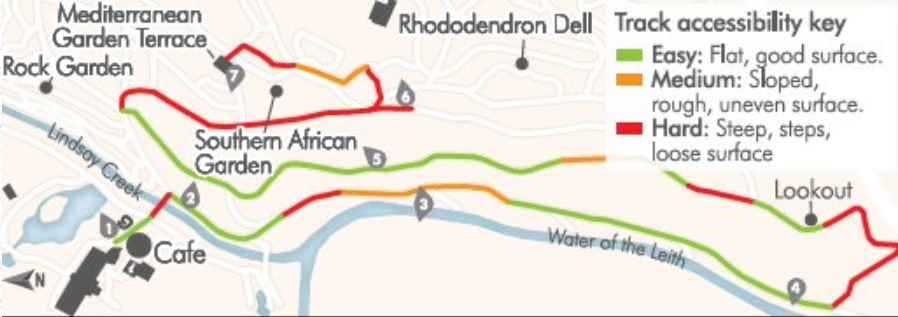
Dunedin has in the past gone off with a bang. You can still see the evidence, Clare Fraser writes.
Dunedin City has grown on top of a long extinct, ancient volcano that influenced the soil we live on top of today.
There were at least two main vents, one near Port Chalmers and the other at Hoopers Inlet, with many more small volcanic centres around the city. There were at least three eruptive phases and Dunedin Botanic Garden is the best spot in the city to see the graphic results of millions of years of these violent changes.
In the Dunedin Botanic Garden the volcano left a lot of basalt rock. Basalt lava shot up from deep within the earth as part of the first eruptive phase about 16 million years ago. More than 90% of the world's volcanic rocks are primitive basalt.


Trachybasalt took a long time to reach the surface. Cooked underground by pressure and temperature, its chemistry evolved, affecting its mineral content. Eventually, weathering, insect action and penetration by plants' roots converted this raw building block into beautiful, rich soil with particularly high levels of nickel, copper, zinc and other essentials for life. Both basalt and trachybasalt supported expansive forest, similar to what remains on Mt Cargill. A few trees from that original forest are dotted through the wider city and at least one still remains in Dunedin Botanic Garden.
The volcano's second eruptive phase also produced a rock so rare it forms less than 1% of exposed volcanic rock worldwide. When phonolite erupts as lava it is very sticky and doesn't spread very far, so tends to form domes. Many of the peaks around Dunedin are actually domes of phonolite. An exposed specimen is visible inside the botanic garden, just in from the Dundas St bridge and across the river.
Phonolite was underground for even longer than basalt or trachybasalt, and is the most evolved rock type in the botanic garden. All this processing means that once again, it contains its own special chemical cocktail of minerals essential for plant life.

Although these rocks came directly from the volcano, others are made in a more circuitous way, from the remnants of other rocks. Well before the birth of Dunedin Volcano, some 250 million years ago, erosion deposited loose sediment on the sea floor. Over time, the sediment was buried, crushed and heated into a new rock that was pushed up through the crust to form the Silver Peaks.
But some of it was destined to keep travelling. Rain and rivers washed rocks down the hill, tumbling against each other, sandpapering them down to smooth, round boulders. Today these boulders are visible at the edge of the botanic garden in The Water of Leith near Gore Place.
Sedimentary rocks also eventually become soil, but unlike basalt, which contains minerals tightly packed together, sedimentary rocks are much more loosely packed together. These form soils with good drainage and freely available nutrients. Because sedimentary rocks can consist of layers, their soil creation process is comparatively fast. This offers an early home for plant life when a new ecosystem is forming.
Sedimentary rocks can also form from activity between eruptions. On the hill above The Water of Leith is a slightly odd looking rock that marks the dormant period after an eruption. While the volcano slept, old lava flows were scraped away, then pressed and squashed to form this new sedimentary rock. You can still see dark fragments of the original volcanic rock inside.
As to what scraped away the original rock, it could have been weathering or maybe even an ancient river. This might have had a completely different source to the hills that birth The Water of Leith today. It might have even flowed in a completely different direction. Things were so different that the Leith probably didn't even exist then.

Despite today's resulting rock being only metres thick, it represents a huge time period between eruptions, perhaps lasting millions of years. The third and final eruption of Dunedin Volcano happened a recent 10 million years ago.
In partnership with GNS Science, Dunedin Botanic Garden is about to launch a self-guiding interpretive trail leading visitors through these layers of time. The trail starts at the information centre with rocks that erupted first, then winds up the side of the hill to the youngest rocks in the Rhododendron Dell. GNS Science geologist Adam Martin will launch the interpretive trail by leading a walk around the route tomorrow, rain or shine, starting at the information centre at 2pm and finishing about 3.30pm.
As for the future of the volcano, don't worry: the volcano has not erupted for a long time and is considered extinct.
Of rock and earth

Over time, water leaches through rock and soil, carrying nutrients away, leaving the soil acidic (like a lemon). Soils that formed from certain rocks have a greater ability to resist this acidification than others. Under certain rare conditions of rock type, climate and location, some soils can become alkaline (like soap), the opposite of acidic.
Plants do best in soil that is neither highly acidic nor highly alkaline because both extremes limit nutrient availability: somewhere in between is good.
Nevertheless, different plant species are adapted to soils of different acidity and alkalinity. For example, the native kowhai, Sophora longicarinata, grows on alkaline limestone whereas rimu (Dacrydium cupressinum) will tolerate acidic soils.
Clare Fraser is information services officer at Dunedin Botanic Garden and Adam Martin is a geologist at GNS Science.












